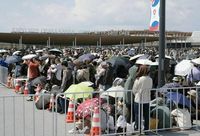The Osaka-Kansai Expo is set to open on April 13, 2025, with approximately 160 countries participating in this monumental event. Spanning 184 days until October 13, 2025, the Expo will be held on Yumeshima, an artificial island in Osaka Bay. However, the lead-up to this international exhibition has been marred by significant challenges, including rising construction costs, delays in building, and disappointing advance ticket sales.
A recent test run conducted from April 4 to April 6, 2025, aimed to simulate the visitor experience and highlight any operational flaws. Unfortunately, it revealed substantial hurdles in achieving the Expo's promise of a "no-queue" environment. Long lines formed at the entrance gates, with many attendees waiting over an hour to enter. Reports indicated that some corporate pavilions had wait times as long as three hours, raising concerns about crowd management as the opening day approaches.
Located near the entrance gate, Yumeshima Station on the Osaka Metro Chuo Line was not fully operational during the test run, exacerbating the congestion issues. The station's recent extension was intended to facilitate access, but instead, it contributed to overcrowding in the concourse and stairways. Visitors were often left lingering in the plaza area outside, creating a bottleneck that could lead to potential safety risks.
Isao Kinoshita, a journalist and co-author of the book "The Essence of the Osaka-Kansai Expo 'Failure'", has been vocal about the concerns surrounding safety and disaster prevention at the Expo site. He notes that the location of Yumeshima, a land reclaimed from Osaka Bay, poses significant challenges due to its weak ground and limited access routes. Kinoshita emphasizes that these factors render the site particularly vulnerable, questioning the political motivations behind selecting such a problematic location for a major international event.
Despite the Expo's ambitious goals, safety issues remain unresolved as the opening day approaches. The limited access routes to Yumeshima have raised alarms about the excessive strain the Osaka Metro will face from the influx of visitors. Kinoshita's book delves into the political implications of these challenges, suggesting that the choice of venue reflects broader political agendas rather than practical considerations.
In addition to operational challenges, the Expo's ticketing process has also come under scrutiny. The Japan Association for the 2025 World Exposition announced that it will begin selling simplified admission tickets called "EXPO Quick" starting April 13, 2025, at midnight. This new ticketing system aims to streamline the entry process, allowing visitors to purchase tickets via smartphone or PC without the need for prior registration.
The "EXPO Quick" tickets will allow customers to select their visit date, entry time, entry gate, and the number of tickets. After payment, a 12-digit code will be displayed, granting entry to the venue. Ticket prices vary based on the day of the week: weekday tickets are set at 6,000 yen for adults, 3,500 yen for junior high students, and 1,500 yen for elementary school students. Weekend and holiday tickets will cost 7,500 yen for adults, 4,200 yen for junior high students, and 1,800 yen for elementary school students. Evening tickets, available after 5:00 PM, are priced at 3,700 yen for adults, 2,000 yen for junior high students, and 1,000 yen for elementary school students.
However, the "EXPO Quick" tickets come with limitations. Changes to the visit date, time, or entry gate after purchase will not be permitted, and pre-booking for pavilions and events is not possible with these tickets. For those wishing to visit popular pavilions or events that require reservations, same-day registration will be available at information centers within the venue.
As the Expo draws near, the anticipation among participants and visitors alike continues to grow. However, the concerns raised by Kinoshita and others about safety and operational efficiency highlight the need for careful planning and management. With the event set to attract millions of visitors, ensuring a smooth and safe experience will be critical to the Expo's success.
In addition to the operational challenges facing the Osaka-Kansai Expo, various prefectures in Japan are preparing to showcase their unique cultural offerings. For instance, Okinawa Prefecture will present empty-handed martial arts to promote the birthplace of karate, while Yamaguchi Prefecture will highlight its famous pufferfish and Japanese sake. These regional showcases will add a rich tapestry of cultural experiences to the Expo, aiming to captivate both domestic and international audiences.
Ultimately, the Osaka-Kansai Expo represents a significant opportunity for Japan to demonstrate its resilience and innovation on the world stage. However, the challenges that have emerged in the lead-up to the event serve as a reminder of the complexities involved in hosting such a large-scale international exhibition. As the countdown to the opening day continues, stakeholders must address these issues to ensure that the Expo fulfills its promise of being a memorable and safe experience for all attendees.






